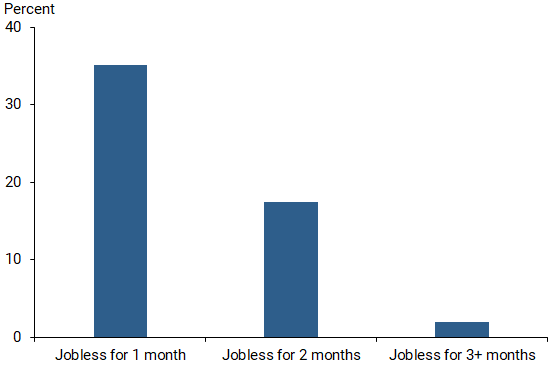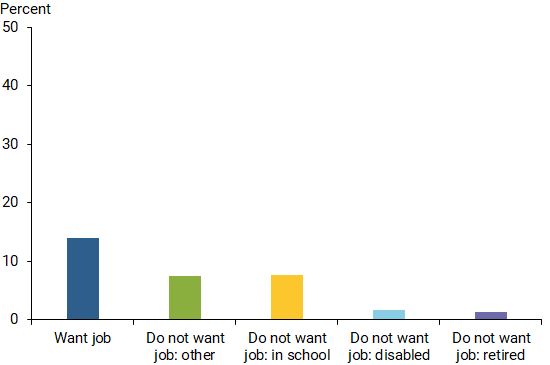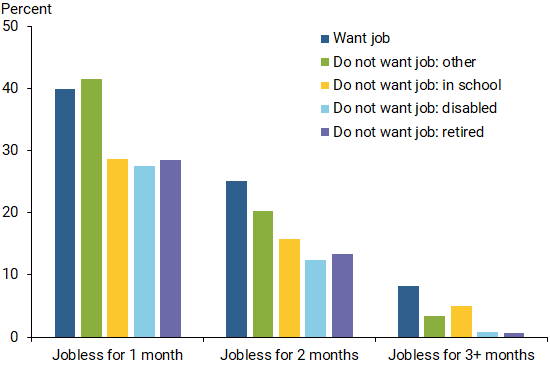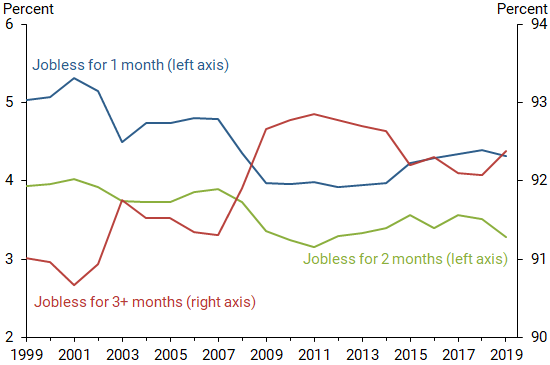The best predictor of someone from outside the labor force finding a job is how recently the person was employed, rather than their self-reported desire to work as is conventionally thought. Between 1999 and 2019, the composition of the out of the labor force group shifted towards people out of work for longer. Consequently, the pool has become less employable. This indicates that, even though the out of the labor force pool is larger, it does not signify additional labor market slack beyond that accounted for by the standard unemployment rate.
Most people who are not employed are also not actively searching for work and thus are not counted as part of the labor force. The share of the population that fits this description, known as out of the labor force (OLF), is the largest it has been in four decades. This increase has coincided with a historically low unemployment rate, which raises a concern: is there additional weakness in the labor market that the standard unemployment rate is not capturing?
This Letter measures the composition of OLF in terms of employment potential, that is, the probability that people will transition from OLF to work. If the employment potential of OLF is relatively high, then the unemployment rate may be missing some labor market slack.
In recent work, Fabian Lange and I show that the duration of joblessness, that is the duration since the most recent employment, is an important predictor of transitions to employment for those OLF (Kudlyak and Lange 2018). In this Letter, I compare the composition of the OLF pool by the duration of joblessness in 2018 to the composition in the business cycle peak years of 1999 and 2007. This comparison reveals that the composition of OLF shifted towards individuals who have been out of work for longer periods and thus typically have low job-finding rates. That is, the average OLF individual is less likely to become employed. Consequently, even though the size of the OLF group is unusually large, this does not represent additional slack in the labor market beyond what is captured by the standard unemployment rate.
Job-finding rates for OLF by duration of joblessness
Kudlyak and Lange (2018) find that the duration of joblessness is a more important predictor than the conventionally used self-reported desire to work. Even those who do not want a job but were recently employed have a higher probability of becoming employed than those who report wanting a job but were not recently employed.
The duration of unemployment is the key determinant of the job-finding rate for the unemployed. Data on the duration come from the Current Population Survey (CPS), which is the main source of labor market statistics in the United States compiled by the Bureau of Labor Statistics (BLS). In the CPS, unemployed people are asked how long they have been looking for work.
But no such question exists for the OLF. In Kudlyak and Lange (2018), we use the panel structure of the CPS to construct a measure of the duration of joblessness for OLF individuals from their labor market activities. We match the respondent’s records across interviews to create four-month sequences of an individual labor force status. From the data, we can distinguish between three categories: jobless for one month, which counts those OLF who were employed in the previous month, jobless for two months, and jobless for three months or longer.
Figure 1 shows the average monthly probability of transitioning from OLF to employment by duration of joblessness. As the duration increases, the probability of transitioning to employment declines. Those OLF who were employed last month have a 35% probability of transitioning to work the following month. For those OLF who are jobless for two months, the probability is 17.5%, and for those who are jobless for three months or longer, the probability drops to 2%. These patterns hold regardless of gender, age, and education.
Figure 1
Job-finding rates of OLF individuals by jobless duration

Source: Author’s calculations using CPS microdata merged across consecutive interview months, monthly average, January 1994 to July 2019. See Kudlyak and Lange (2018) for more details.
Duration of joblessness versus self-reported desire to work
In the CPS, individuals out of the labor force are asked a series of questions to determine their degree of attachment to the labor market, including whether they want a job. Among those who do not want a job, the BLS distinguishes between individuals who are retired, disabled, in school, and other.
Figure 2 shows the average monthly probability for transitioning from OLF to employment divided between those who want a job and those who do not. For those who do not want a job, the figure distinguishes among those in school, disabled, retired, and other. The figure confirms the findings in a large body of related research, that those people who report wanting a job find one more frequently than those who do not want a job (Flinn and Heckman, 1983; Hall and Schulhofer-Wohl, 2018).
Figure 2
Job-finding rates of OLF individuals by desire to work status

Source: Author’s calculations using CPS microdata merged across consecutive interview months, monthly average, January 1994 to July 2019. See Kudlyak and Lange (2018) for more details.
The job-finding rate of an OLF individual who wants a job is 14%. The job-finding rate of an OLF individual who does not want a job and is either disabled or retired is 1.6% and 1.3%, respectively. The job-finding rate of an OLF individual who does not want a job and is in school or in the “other” category is half the rate of those who want a job at 7.6% and 7.5%, respectively. The pattern in Figure 1 holds true across a broad range of sociodemographic characteristics, including gender, age, and education.
Figure 3 shows how job-finding rates vary depending on duration of joblessness and self-reported desire to work, comparing the predictive power of these two factors in explaining the transition from OLF to employment. First, the figure shows that the duration of joblessness is a more powerful predictor of transitions to employment than the desire to work. Those OLF who are jobless for one month, even if they do not want a job and are retired or disabled, have higher job-finding rates than those who were jobless for two months or longer and want to work.
Figure 3
Job-finding rates by jobless duration and desire to work

Source: Author’s calculations using CPS microdata merged across consecutive interview months, monthly average, January 1994 to July 2019. See Kudlyak and Lange (2018) for more details.
Second, among people who have been jobless for one month, those who do not want a job and are not retired, disabled, nor in school have similar job-finding rates as those who want a job. But among people who have been jobless for longer than one month, those who want a job tend to have higher job- finding rates than those who do not. In fact, the majority of those who want a job have no recent employment and, therefore, have low employment transition rates (Kudlyak and Lange 2018).
Changes in OLF composition by jobless duration
The composition of the OLF by duration of joblessness changes over time. Some of the changes are temporary and reflect business cycle fluctuations; other changes reflect long-run developments in the economy and labor market. Figure 4 shows the composition of the OLF in terms of jobless duration. I compare 2018, the most recent full year for which data are available, to 1999 and 2007, the years of the most recent business cycle peaks. The years 1999 and 2018 are especially good for comparison since the unemployment rates were very similar, in fact a bit lower in the later year: 4.2% in 1999, and 3.9% in 2018.
Figure 4
Composition of the OLF by duration of joblessness

Source: Author’s calculations using CPS microdata merged across consecutive interview months, monthly average.
The share of those with the shortest duration of joblessness (one month) in the OLF declined from 5% in 1999 to 4.4% in 2018, more than a 10% decline. The share of the OLF who have been out of work for three months or longer, and thus have low job-finding rates, increased from 91% in 1999 to 92.1% in 2018.
The compositional change by duration of joblessness might appear small. However, the change should be interpreted relative to the size of OLF in the population. Between 1999 and 2018, the labor force participation rate declined from 67.1% to 62.9%, increasing the share of those OLF in the population by more than 4%. Combining these numbers with the results in Figure 4 indicates that the population share of the OLF who have been out of work for three months or longer increased 4%. That is, almost the entire increase in the OLF between 1999 and 2018 is associated with the shift towards groups with longer durations of joblessness. Consequently, the composition of the OLF pool has shifted towards individuals with lower job-finding rates.
This finding is consistent with the current level of the non-employment index, a broader measure of resource utilization in the labor market (Hornstein, Kudlyak, and Lange 2014; Kudlyak 2017). The non-employment index aggregates all the non-employed in the population—the unemployed and the OLF—using their relative job-finding rates. The most recent reading of the index from September 2019 indicates that the labor market is tighter than in 1999–2000.
Conclusion
The labor force participation rate in 2019 was more than 4% lower than its peak at the end of the 1990s. That is, the share of individuals out of the labor force has increased. Even though the unemployment rate is at a historically low level, there is some concern that the official unemployment statistics could be masking the employment potential of non-employed people.
This Letter finds that the share of the OLF that had longer durations of joblessness increased in 2018 compared with 1999. The longer the duration of joblessness, the lower the probability a person has to transition to employment. This indicates that the composition of OLF shifted towards groups with typically lower job-finding rates. Thus, even though the number of OLF individuals in the population has increased, their propensity to become employed is lower.
This finding is consistent with the results obtained from the non-employment index, a broad measure of resource utilization that takes into account all the non-employed and weighs them by their relative job- finding rates (Hornstein, Kudlyak, and Lange 2014). As of November 2019, the non-employment index was even lower than during the tight labor market of the late 1990s. Thus, the standard unemployment rate and the broader measure that includes both the unemployed and the OLF indicate a tight labor market.
Marianna Kudlyak is a research advisor in the Economic Research Department of the Federal Reserve Bank of San Francisco.
References
Flinn, Christopher J., and James J. Heckman. 1983. “Are Unemployment and Out of the Labor Force Behaviorally Distinct Labor Force States?” Journal of Labor Economics 1(1), pp. 28–42.
Hall, Robert E., and Sam Schulhofer-Wohl. 2018. “Measuring Job-Finding Rates and Matching Efficiency with Heterogeneous Job Seekers.” American Economic Journal: Macroeconomics 10(1), pp. 1–32.
Hornstein, Andreas, Marianna Kudlyak, and Fabian Lange. 2014. “Measuring Resource Utilization in the Labor Market.” FRB Richmond, Economic Quarterly 2014:Q1.
Kudlyak, Marianna. 2017. “Measuring Labor Utilization: The Non-Employment Index.” FRBSF Economic Letter 2017-08 (March 27).
Kudlyak, Marianna, and Fabian Lange. 2018. “Measuring Heterogeneity in Job Finding Rates among the Non-Employed Using Labor Force Status Histories.” FRB San Francisco Working Paper 2017-20.
Opinions expressed in FRBSF Economic Letter do not necessarily reflect the views of the management of the Federal Reserve Bank of San Francisco or of the Board of Governors of the Federal Reserve System. This publication is edited by Anita Todd and Karen Barnes. Permission to reprint portions of articles or whole articles must be obtained in writing. Please send editorial comments and requests for reprint permission to research.library@sf.frb.org
